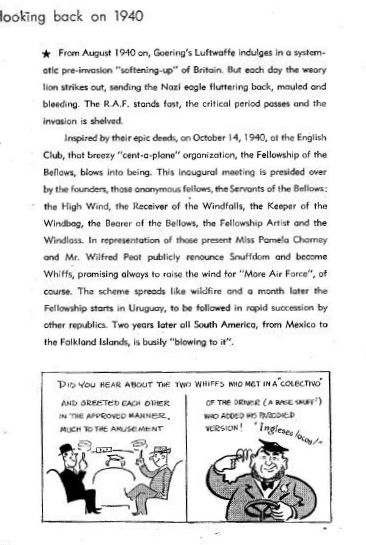Bellows
It’s known that there were a lot of Whirlwinds marked as ‘Bellows’, ‘Bellows Uruguay’ ‘Bellows Argentina’ etc – and that 263 Squadron was known as the ‘Bellows Squadron’. However, the details of how and why aircraft were at various times marked ‘Bellows’ are quite complex.
Initially, several subscription aircraft were delivered to both squadrons with a full inscription (‘Fellowship of the Bellows’, “Bellows Argentina I, II etc). It seems that word got back to Buenos Aires that a squadron was being equipped entirely from the Argentinian contribution, where of course the reality of aircraft allocations, movements, losses and replacements was a lot more complicated. What is known is that In June 1942, presumably for the sake of PR, someone somewhere decided to announce that 263 was a new squadron, formed with Bellows sponsorship. The Buenos Aires ex-pat journal, of which more below, proudly reported “June 17th 1942 – The first Whirlwind squadron, paid for by the United Fellowship of the Bellows, takes to the air”
All was well until a Gaumont camera crew turned up in November 1942 to make a short film for the benefit of the Argentinian Bellows organisation. In the resulting footage the hastily-added ‘Bellows’ under the cockpits of the featured aircraft can very clearly be seen!

Who were the 'Bellows'?
At the outbreak of World War II there was a mature British ex-pat community across all of South America – in the case of Argentina there was a large and established Anglophone business community in Buenos Aires. Argentina maintained its neutrality throughout most of the conflict (finally declaring war on the Axis powers in March 1945), though the government did display German sympathies for the most part. In this period, the British ex-pat community set about being as disruptive to the Nazis as possible, while preserving an image of eccentric harmlessness that seemed to have had the strong German presence completely taken in.

At the same time, the impulse was to support Britain in what was, at the time, a desperate struggle for survival. Several ad-men of the Ernst Berg advertising agency got together at the English Club to form the ‘Fellowship of the Bellows’, led by William Rumboll (self-styled ‘High Wind’ of the ‘Air-nonymous Fellowship of the Bellows’). These were advertising copywriters by trade, and it showed in everything the Bellows did – all was double-meaning, punning and irony. Even the name was code for what this apparently whimsical ex-pat social club was really about – Bellows create ‘More Air Force’ . ..and they also ‘Put the Wind Up’. The Bellows organisation spread across South America, with contributions coming in from as far afield as Uruguay, Bolivia, Colombia, Mexico and even the Falklands.

The basic money-donation scheme grew subtler, with sums being payable according to the official enemy aircraft claims of the Air Ministry – a self-set rate per aircraft, the minimum being 1 Centavo.They had a secret finger-rotating signal to identify themselves to each other, and they had an intricate system of rankings – ‘Whiffs’ (joiners), ‘Puffs’ (payers) and ‘Snuffs’ (non-payers). The Secretaries were ‘Whirlwinds’, while the treasurer was ‘Receiver of the Windfalls’.. This was only one of the activities of this community – there was much work for British intelligence as well – Bill Rumboll himself operated a secret radio broadcasting details of German shipping movements, and later became a fully paid-up member of MI6.
Bellows Argentina was formally wound-up with a big party in Buenos Aires in 1946. I believe any remaining funds were put to local good causes. When the Fellowship of the Bellows was wound up the total amount collected was Pesos 9,542,734.58 (approx. £600,000) of which Argentina was responsible for Pesos 3,140,000.00 (approx. £200,000). This had been sent to the Ministry of Aircraft Production through the British Patriotic Fund. In addition, Pesos 747,228.60 (approx. £50,000) was sent to the RAF Benevolent Fund, and Pesos 16,298 (approx. £1,000) was used to assist Argentine scholars abroad. The total number of Fellows was estimated to be over 200,000 including 56,000 in Argentina and 35,000 in Uruguay. On September 7th 1945, the ‘Fellowships of the Bellows’ blew themselves out at a mammoth ‘Deflation Party’ at the Plaza Hotel, Buenos Aires attended by more than 1000 ‘fellow bellows’, including specially selected young ladies to represent each of the many Latin American countries that had raised funds in this way.
Nearly 10 million Pesos (approx. £600,000) had been raised at a time when a Spitfire cost £5,000. The founders of the Fellowship of the Bellows maintained their anonymity throughout their lives and eschewed any publicity. However, the identity of the principals can now (2014) formally be made public. The High Wind was E A (Bill) Rumboll, who was with Ernst Berg & Cia (Advertising Agency) and also worked for British Intelligence in Buenos Aires until he had to flee to Britain when his cover was blown. Some countries involved were Argentina, Brazil, Chile, Bolivia, Uruguay, Mexico, Colombia, Venezuela and the Falkland Islands. Uruguay had a Whirlwind of its own.
Fiji was not a Bellows organisation, it was the Governor and his wife, Mr and Mrs. Ellis. Interestingly ‘Pride of Yeovil’ P7056 was a presentation aircraft – from the local ‘Buffalo’ lodge, Yeovil branch – which was called the ‘Pride of Yeovil’ Lodge.